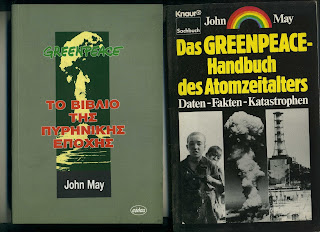Belorussian journalist Svetlana Alexievich recorded more than 500 interviews with eyewitnesses of the disaster and its aftermath and crafted them into a new form of oral history that earned her the Nobel Prize for Literature in 2015.
Its impossible not to be moved to tears by these accounts. Her valuable work brings us a broader multidimensional view of the catastrophic social, cultural and medical effects produced in the wake of the Chernobyl disaster.
She writes:
'How many times has art rehearsed the apocalypse, offered different technological versions of doomsday? Now, though, we can be assured that life is infinitely more fantastical.'
One in five live in the contaminated zone - a total of 2.1 million people of which 700,000 are children.
After Chernobyl, the country lost 485 villages and towns, seventy remain buried forever beneath the earth. Radiation is the leading cause of the country's demographic decline. In the worst hit provinces, the mortality rate outstrips the birth rate by 20 per cent.
The Chernobyl disaster released 50 million curies of radioactivity into the atmosphere; 70 per cent of this fell on Belarus, contaminating 23% of the country's land.
As a result of constant exposure to low-dose radiation, every year Belarus sees a rise in the incidence of cancer, child mental retardation, neurospychiatric disorders and genetic mutations.
These quoted facts come from the entry on Chernobyl in the Belorusskaya Entsiklopediya [1996]
Svetlana Alexievich explains her approach and motives in an essay entitled 'The author interviews herself on missing history and why Chernobyl calls our view of the world into question.' Here are two brief extracts:
'I see Chernobyl as the beginning of a new history: it offers not only knowledge but also prescience, because it challenges our old ideas about ourselves and the world. When we talk about the past or the future, we read our ideas about time into those words; but Chernobyl is, above all, a catastrophe of time. The radionuclides strewn across our earth will live for 50,000, 100,000, 200,000 years. And longer. From the perspective of human life, they are eternal.
'This is not a book on Chernobyl, but on the world of Chernobyl... What I'm concerned with is what I would call the 'missing history', the invisible imprint of our stay on earth and in time. I paint and collect mundane feelings, thoughts and words. I am trying to capture the life of the soul. A day in the life of ordinary people. Here, though, everything was extraordinary: both the event itself and the people as they settled into the new space. Chernobyl for them is metaphor: it is home.'
*In between reading thinking in that dark night, I listened to 'Up All Night' on BBC Radio 5 where a energy expert was interviewed about the nuclear energy industry post Chernobyl. He said the problem is that the technology evolves very slowly.
The only new type of reactor that claims to be safer - the European Pressurised Reactor (EPR) - is dogged with problems and cost overruns. The first two of these are in Finland and France and two others are supposed to be being built in England at Hinkley Point. These two 1.65GW European pressurised reactors would be among the biggest in the world. The smart money says the project is doomed.
Decommissioning ageing nuclear plants is an incredibly expensive and technically challenging process. Disposing of nuclear waste also raises major problems.
In the last five years, the massive expansion of solar energy and wind proves that this is the direction of travel - a point underlined by the fact that the Saudi government has announced a $2 trillion investment fund for solar energy aimed at weaning their nation off oil within just 20 years
*
TYPE CHERNOBYL INTO THE SEARCH BOX TO READ A SET OF SIX PREVIOUS POSTS ON CHERNOBYL.As a result of Chernobyl, I worked with Greepeace running their international publishing operation and producing a number of books including the organisation's official history. One of these was 'The Greenpeace Book of the Nuclear Age' which was at the time the most comprehensive record of civil and military nuclear accidents.



VARIOUS EDITIONS:
(Top Left) Gollancz (UK)/Pantheon (US); (Top Right) Selas (Greece), Knaur (Germany)
(Bottom left) M&P Document (Netherlands)/Frassinelli (Italy); (Bottom right) Ordfront (Sweden)


No comments:
Post a Comment